Micro-investment serves as a powerful tool for empowering diverse communities by providing accessible financial resources that foster wealth and economic independence. Through small contributions, individuals can collectively create significant change, as seen in inspiring stories from various communities across the United States. These initiatives not only support low-income families and entrepreneurs but also democratize the investment process, making it possible for anyone to start building their financial future with minimal funds.
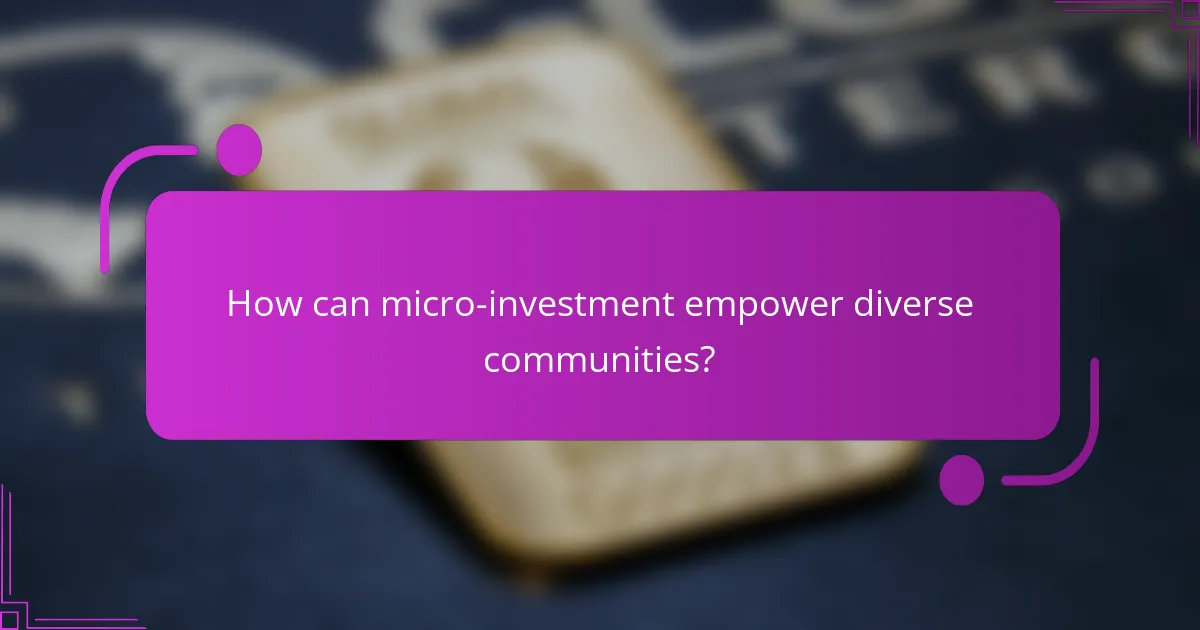
How can micro-investment empower diverse communities?
Micro-investment can empower diverse communities by providing them with the financial tools and resources necessary to build wealth and foster economic independence. By enabling individuals to invest small amounts of money, these initiatives can lead to significant collective impact and growth within underrepresented groups.
Increased financial literacy
Micro-investment programs often include educational components that enhance financial literacy among participants. By teaching budgeting, saving, and investment strategies, these programs help individuals make informed financial decisions, ultimately leading to better economic outcomes.
For example, workshops may cover topics like understanding interest rates, the importance of credit scores, and how to evaluate investment opportunities. This knowledge empowers community members to take control of their financial futures.
Access to capital for small businesses
Micro-investment provides crucial access to capital for small businesses, particularly in underserved areas. Traditional financing options can be limited for entrepreneurs from diverse backgrounds, making micro-investment a viable alternative for funding their ventures.
Through platforms that facilitate micro-loans or crowdfunding, small business owners can raise the necessary funds to start or expand their operations. This not only stimulates local economies but also creates job opportunities within the community.
Community-driven investment initiatives
Community-driven investment initiatives focus on pooling resources from local residents to support projects that benefit the community as a whole. This collective approach fosters a sense of ownership and accountability among participants.
Examples include community gardens, local art projects, or cooperative businesses that reflect the values and needs of the community. By investing together, members can ensure that their contributions directly impact their surroundings and enhance community well-being.

What are inspiring micro-investment stories from the United States?
Micro-investment stories from the United States highlight how small financial contributions can lead to significant changes in individuals’ lives and communities. These stories often showcase platforms that empower low-income families and entrepreneurs to achieve their financial goals through accessible investment options.
Success of the Kiva platform
Kiva is a nonprofit organization that allows individuals to lend money to entrepreneurs in the U.S. and around the world. By providing micro-loans as small as $25, Kiva enables borrowers to fund their businesses, education, or personal projects without high-interest rates. This model has proven successful, with many borrowers repaying their loans and reinvesting in their communities.
For instance, a small business owner in a low-income neighborhood can receive funding through Kiva to purchase equipment or inventory. This not only helps the entrepreneur grow their business but also creates jobs and stimulates local economic development.
Impact of Acorns on low-income families
Acorns is a micro-investing app that allows users to invest spare change from everyday purchases. By rounding up transactions to the nearest dollar and investing the difference, Acorns makes investing accessible to those who may not have large sums to invest upfront. This approach has particularly benefited low-income families by encouraging saving and investment habits.
For example, a family that regularly uses Acorns can accumulate savings over time, which can be used for emergencies, education, or future investments. The app also provides educational resources to help users understand investing, fostering financial literacy among its users.

How do micro-investment platforms work?
Micro-investment platforms allow individuals to invest small amounts of money, often through mobile apps, making investing accessible to a broader audience. Users can typically start with minimal funds, often as low as $5, and the platforms automate the investment process, enabling users to build portfolios over time.
Overview of micro-investment models
Micro-investment models generally focus on fractional shares, allowing users to purchase portions of stocks or ETFs instead of whole units. This approach democratizes investing, enabling participation from those who may not have significant capital. Many platforms also offer round-up features, where purchases are rounded up to the nearest dollar, and the difference is invested automatically.
Some models emphasize thematic investing, where users can invest in specific sectors or causes, such as renewable energy or technology startups. This allows investors to align their portfolios with personal values while still engaging in the market.
Comparison of platforms like Stash and Robinhood
Stash and Robinhood are popular micro-investment platforms, but they cater to different user needs. Stash focuses on education and offers personalized investment advice, making it suitable for beginners. Users can invest in fractional shares and choose from various investment themes, with a monthly subscription fee for premium features.
In contrast, Robinhood is known for commission-free trading and a user-friendly interface, appealing to those who prefer a more hands-on approach. It allows users to trade stocks, ETFs, and cryptocurrencies without fees, but it lacks the educational resources that Stash provides. Both platforms have their strengths, so users should consider their investment goals and experience level when choosing between them.
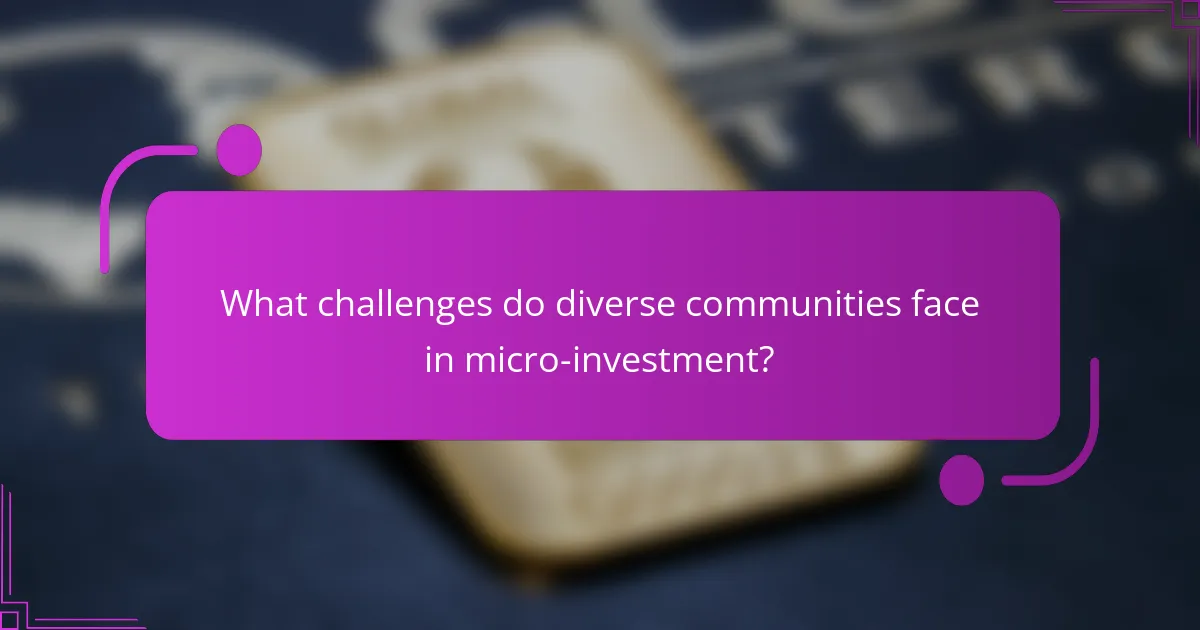
What challenges do diverse communities face in micro-investment?
Diverse communities often encounter significant challenges in micro-investment, including limited access to information and resources. These barriers can hinder their ability to participate in investment opportunities that could enhance their financial stability.
Lack of awareness and education
Many individuals in diverse communities are unaware of micro-investment options available to them. This lack of awareness can stem from insufficient financial education, which leaves potential investors uninformed about the benefits and risks associated with micro-investing.
To address this, community organizations can offer workshops or online resources that explain micro-investment concepts in simple terms. Engaging local leaders to promote these educational initiatives can also enhance outreach and participation.
Barriers to technology access
Access to technology is a crucial factor in micro-investment participation. Many individuals in diverse communities may lack reliable internet access or the necessary devices, which limits their ability to engage with online investment platforms.
To overcome these barriers, initiatives could include providing community access points, such as libraries or community centers, equipped with computers and internet. Additionally, mobile-friendly investment apps can help reach those who primarily use smartphones for internet access.
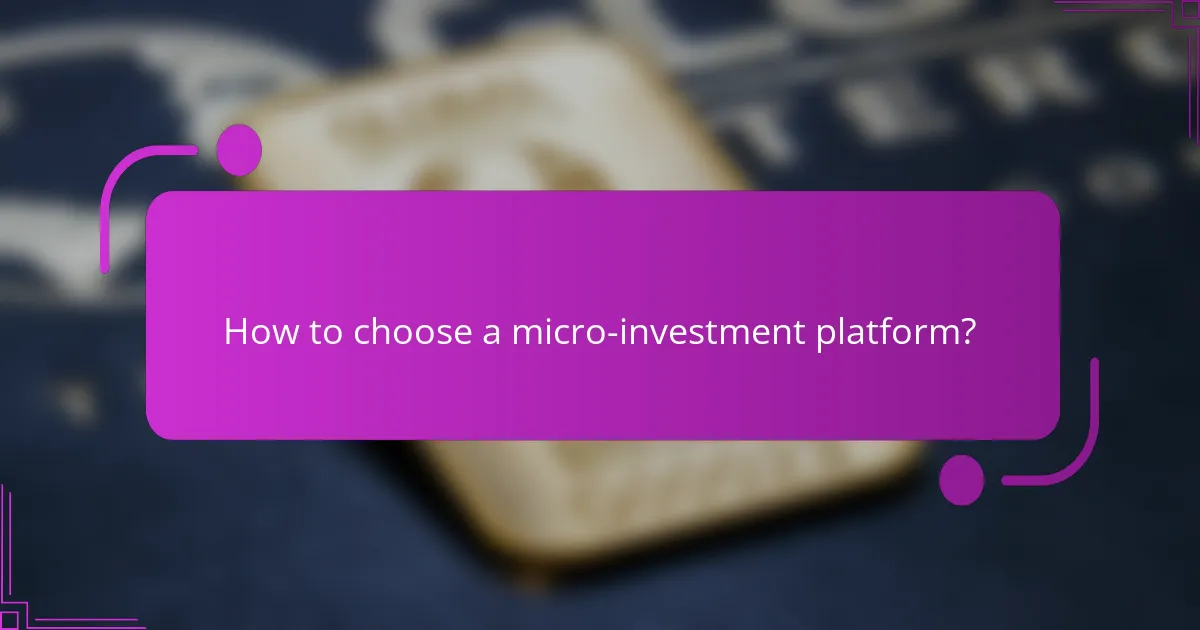
How to choose a micro-investment platform?
Choosing a micro-investment platform involves assessing various factors such as user experience, investment options, and fees. Focus on platforms that align with your financial goals and offer features that suit your investment style.
Criteria for selecting a platform
When selecting a micro-investment platform, consider the user interface, customer support, and security measures. A user-friendly interface helps you navigate easily, while responsive customer support can assist with any issues that arise.
Additionally, check for regulatory compliance, as platforms should adhere to local financial regulations to ensure your investments are protected. Look for platforms that are registered with relevant authorities, such as the SEC in the United States or similar bodies in other countries.
Evaluating fees and investment options
Fees can significantly impact your returns, so evaluate the fee structure of each platform. Common fees include account maintenance fees, transaction fees, and management fees, which can range from a few dollars to a percentage of your investment.
Examine the investment options available, such as stocks, ETFs, or bonds, and ensure they align with your investment strategy. Some platforms may offer themed portfolios or socially responsible investment options, which can be appealing if you have specific values or interests.

What are the benefits of micro-investment for individuals?
Micro-investment offers individuals a way to build wealth gradually by investing small amounts of money. This approach lowers the barrier to entry for investing, making it accessible for those who may not have significant capital to start with.
Building savings habits
Micro-investment encourages individuals to develop consistent savings habits. By setting aside small amounts regularly, users can create a routine that fosters financial discipline. For instance, investing as little as $5 or $10 weekly can accumulate over time, reinforcing the practice of saving.
Using apps that round up purchases to the nearest dollar and invest the difference can further enhance this habit. This method allows individuals to save without feeling the pinch of larger contributions, making it easier to stick to their financial goals.
Opportunities for wealth creation
Micro-investment opens doors to wealth creation by allowing individuals to invest in diverse assets, such as stocks, bonds, or real estate, even with minimal funds. This diversification helps spread risk and can lead to better returns over time compared to traditional savings accounts.
For example, platforms that allow fractional shares enable users to invest in high-value stocks without needing large sums. By starting small, individuals can gradually increase their investment as their financial situation improves, potentially leading to significant wealth accumulation in the long run.
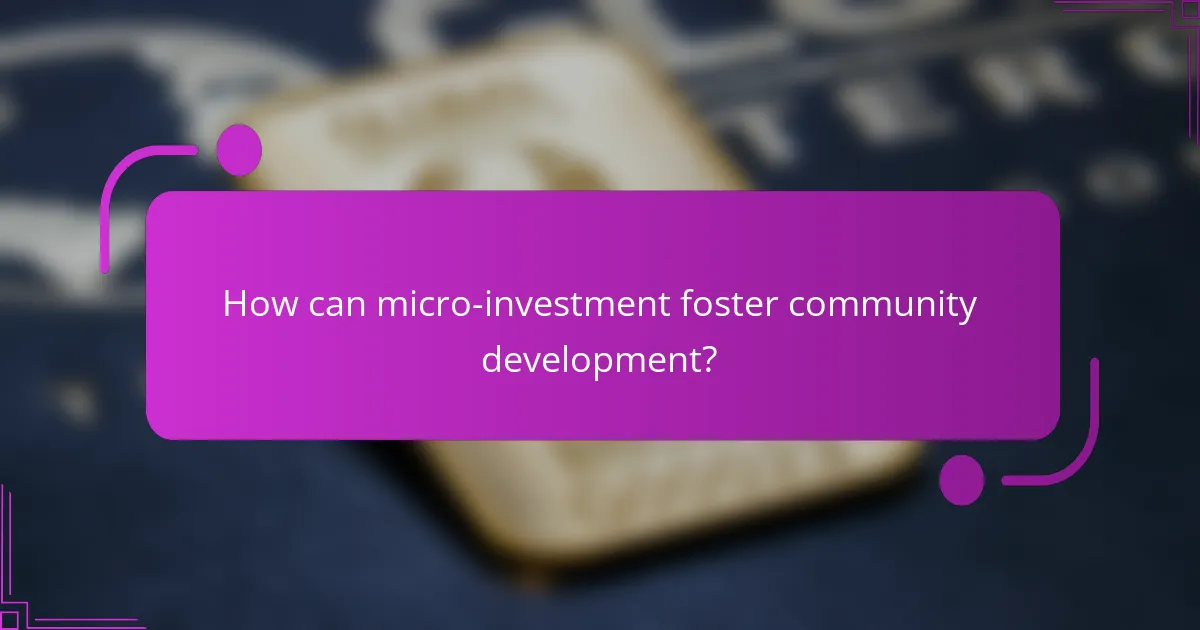
How can micro-investment foster community development?
Micro-investment can significantly enhance community development by providing small-scale funding for local initiatives and empowering individuals to start their own businesses. This approach encourages economic growth and social cohesion within diverse communities.
Funding local projects
Micro-investment allows communities to fund projects that address specific local needs, such as parks, community centers, or educational programs. By pooling small amounts of money from many investors, these projects can become a reality without relying solely on large grants or government funding.
For example, a community might raise a few thousand dollars to renovate a local library or support a neighborhood garden. This funding can create jobs, enhance local infrastructure, and foster a sense of ownership among residents.
Encouraging entrepreneurship
Micro-investment plays a crucial role in supporting entrepreneurship by providing the necessary capital for individuals to start small businesses. This financial support can help cover initial costs such as inventory, equipment, or marketing, which are often barriers for aspiring entrepreneurs.
In many cases, micro-investors can offer not just funds but also mentorship and networking opportunities. For instance, a local café owner might receive micro-investments from community members, allowing them to expand their menu or improve their space, ultimately benefiting the local economy.
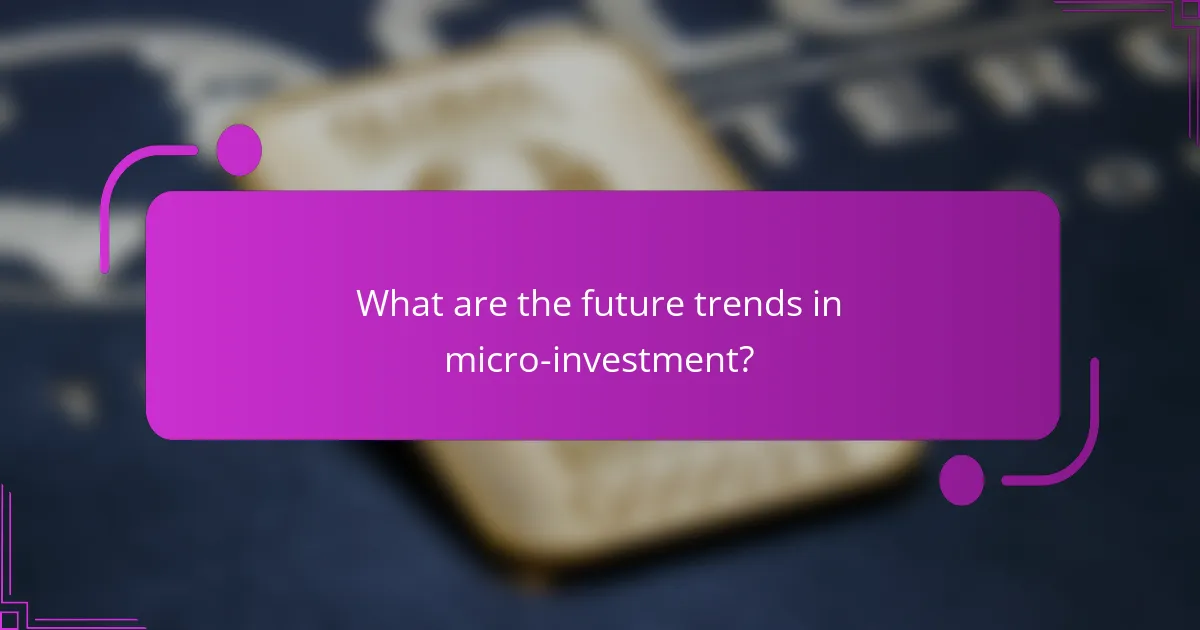
What are the future trends in micro-investment?
Future trends in micro-investment are leaning towards increased accessibility, technological integration, and a focus on community-driven initiatives. As platforms evolve, they will likely offer more personalized investment options and leverage data analytics to enhance user experience.
Increased accessibility through technology
Micro-investment platforms are becoming more user-friendly, allowing individuals from diverse backgrounds to participate with minimal financial barriers. Mobile apps and online platforms enable users to start investing with as little as a few dollars, making it easier for anyone to engage in the investment landscape.
For example, many platforms now offer features like automated investing and round-up savings, where spare change from purchases is invested. This approach not only simplifies the process but also encourages saving and investing among those who may have previously felt excluded.
Community-driven investment initiatives
There is a growing trend towards community-focused investment opportunities, where individuals can pool resources to support local businesses or initiatives. This model fosters a sense of ownership and responsibility within communities, encouraging members to invest in projects that directly benefit them.
For instance, community investment funds allow residents to contribute small amounts towards local startups or social enterprises. This not only supports economic growth but also strengthens community ties, as investors often have a personal stake in the success of these ventures.
Focus on sustainable and ethical investing
As awareness of social and environmental issues rises, micro-investment platforms are increasingly emphasizing sustainable and ethical investment options. Investors are looking for opportunities that align with their values, such as green energy or social justice initiatives.
Platforms are responding by offering curated portfolios that focus on companies with strong environmental, social, and governance (ESG) practices. This shift not only attracts socially conscious investors but also encourages businesses to adopt more responsible practices.



